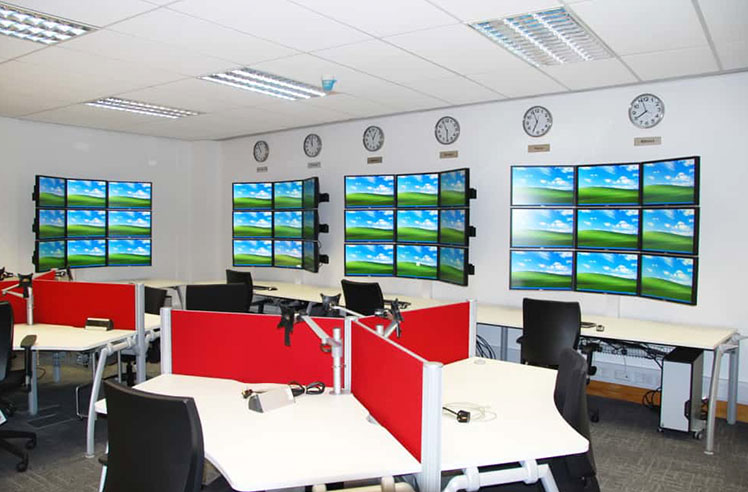Quad Vision are AV specialists and integrate multiple solutions to provide the best possible end result for our customers. We’re not locked in to any one supplier and so carefully select products according to our customer’s operational requirements and their budgets. We take pride in providing the most fit for purpose solutions.
Our enviable client base has provided us with a broad range of experience across a wide variety of sectors.
We live and breathe technology, there is new technology emerging on the market at a steady rate and for some customers it can be hard to digest, understand and make sense of; unless of course you’re already an AV guru in which case you’ve found a like minded company to do business with!
Video wall technology
Ok, so now you know who you are dealing with, let’s look at what we can offer on the video wall technology side of things.
Generally speaking, there are four principal video wall technologies – or in other words, four ways of making your video wall or digital signage system work the way you want it to.
- Video wall controller
- HDMI/Display port daisy chain solution
- Network based controller
- Media player with a content management software
Video walls can provide that WOW factor to your organisation and are an essential component of corporate and control centre communications. Also, hugely versatile in retail as a digital signage solution. It’s important that for each installation the correct technology is specified to achieve optimum performance.
Video wall controller
The traditional approach utilises a dedicated PC (video wall controller) equipped with multiple graphics card, physically attached to the display screens, with each graphic card output operating one display screen.
The video wall controller comes with software and graphics cards to connect multiple inputs, control outputs and manage overall configurations.
These video wall controllers can be an off the shelf solution, however at Quad Vision we build our own, tailored to our customers’ needs with our own user interface. The controllers have a fixed number of inputs and outputs and are designed specifically to work with video walls. Some allow content to be rendered directly on the controller.
What’s great – high resolution output is standard up to 4K per display, and display can be divided and subdivided according to the display that you want to achieve.
Think about – limitations of system expansion.
Ideal installations – command and control rooms, reception areas, high volume traffic areas, public buildings, institutions.
Link to Ultra Electronics case study
HDMI/Display port daisy chain solution
Certain commercial display screen manufacturers supply screens with a built-in daisy chain solution allowing the signal received from a player with a single input source, to project up to 4K content across multiple screens simultaneously. The Samsung UH46N-E is a good example of this.
What’s great – a relatively low-cost video wall solution that is simple to set up.
Think about – higher resolution than 4K would require a system upgrade. Not suitable for streaming multiple content or for using pre-set zones.
Ideal installations – digital signage solution for single retail units, institutions, public buildings.
Link to Bad Apple Hair Salon Case Study
Network based controller
AV-over-IP is the transmission of video, audio and control signals over a network cable structure e.g. LAN, WAN or the internet. Use with a central video wall controller which renders, captures and splits the content, then sends to the display via a standard Ethernet network.
Ultimately scalable as long as the PC is powerful enough and the network has capacity.
Content management is in real time and a wide range of inputs such as HDMI and SDI can be used.
What’s great – multiple video walls can be run off a single PC.
Think about – at least Cat5e cabling is required as distribution is over an IP network at gigabit speeds.
Ideal installations – large institutions/ distributed video walls.
Multiple media player with content management software
A media player is a hardware device which enables content to be managed and played on your display screens. Content can be managed by way of a CMS and be split, timed, consist of multi feeds i.e. video, still images and TV. A media player per display would be required.
A more rudimentary system for smaller scale operations would be to load a USB with content and plug into the media player, simple yet effective in the right situation.
What’s great – multiple content can be managed and displayed.
Think about – potential limited video performance and limits on resolution. More screens, the higher the cost.
In summary
So that’s the basic video wall and digital signage system technology in a nutshell. What you need now is an AV integrator that will help you decide on the best solution for your requirement. A leading edge AV integrator such as Quad Vision has access to and experience in many options and will help you to understand the intricacies of each system and why they may or may not work for you. One size doesn’t fit all when it comes to video wall tech and if you’re considering an investment in a video wall solution, you should consult an expert to fully appreciate what it will deliver for you, how easy it is to manage and if it is scalable or not.
Especially important if your business is to grow.

